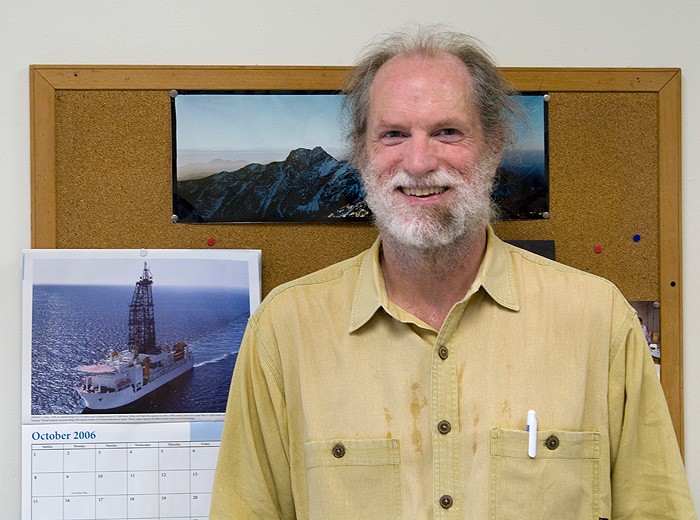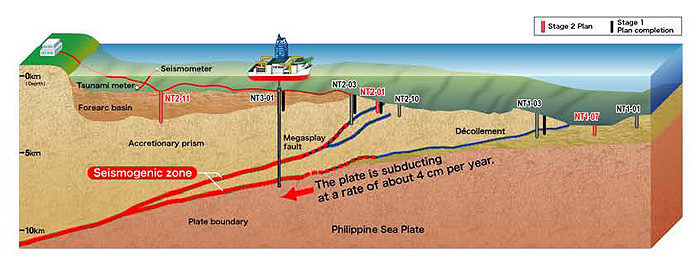
UConn geologist Timothy Byrne has been one of the lead scientists in a long-term earthquake zone experiment off the coast of Japan. Starting in 2007, scientists have worked aboard the research vessel Chikyu, drilling holes deep beneath the seafloor in the Nankai Trough south of the Kii Peninsula, an area known for major earthquakes and tsunamis. Scientists work with drillers and engineers on board the Chikyu to lower sensitive instruments through the drill pipe and bring up core sediment samples to study.
Byrne, an associate professor of marine sciences in the College of Liberal Arts and Sciences and a fellow of the Geological Society of America, participated in Chikyu expeditions in 2007 as a scientist and in 2009 as a co-chief. While a co-chief he helped lead the first scientific drilling expedition to use deep-drilling equipment developed by the oil and gas industry.
This summer, he heads back to Japan to the Kochi Core Center to analyze data and re-examine sediment cores. The research will help scientists understand more about this active fault zone, and when and where future earthquakes might occur.
Were you surprised by this year’s major earthquake and tsunami in northern Japan, and did anything in the Chikyu studies show that it might happen?
I think many of the scientists working in Japan were surprised by the magnitude of the earthquake, as well as by the severity of the tsunami. Northeast Japan has a well-documented history of moderate earthquakes and an occasional tsunami, but as far as we can tell, it’s been nearly 1,200 years since the last earthquake of this magnitude. Tsunamis are also not associated with every earthquake, which adds an additional level of difficulty in analyzing the risks in this area.
What do you hope to learn this summer by studying the sediments gathered so far?
I’ll be looking at suites of faults and fractures in sediment cores we collected in 2009. My overall goal is to document the geometries and kinematics (slip directions) of individual structures and develop a model of the stress field at the time they formed. These results will then be integrated with similar data and models from research resulting from the 2007 expedition to see if there are regional patterns. One of our main long-term goals is to see if and how stresses change before, during, and after major earthquakes.
Describe the size and content of the samples you will be studying.
The drilling pipe essentially cuts a cylinder around the sediments, isolating the sample inside the pipe as drilling occurs. The drill pipe has an inner diameter of about three inches, which is about the diameter of the samples I’ll be studying in Japan. Ideally, we would prefer to core continuously, so a 2000-meter drill hole would yield 2000 meters of core. In 2009, however, we had a number of projects and goals in addition to sampling, so we targeted a critical area at about 1 km depth and obtained 100 meters of sediment. It will take me about a week to collect the data from these cores.
All of the samples are deep-sea muds and silts interlayered with a few volcanic ash layers, probably from volcanoes in Japan. The layers also show extensive evidence of deformation, which is what I’ll be documenting.
What is the potential for another major earthquake in southwest Japan, the area where the Chikyu has been based?
Southwest Japan, including the area south of Kii Peninsula, has a long and well-documented history of great (> magnitude 8 ) earthquakes, which was our primary motivation for targeting this area. The data for past events go back several thousand years and very clearly show that the area is prone to large earthquakes and associated tsunamis. For example, this region suffered magnitude 8 events in 1944 and 1946, and the area is linked with northeast Japan through the area of Tokyo, which experienced a disastrous earthquake in 1923 that killed over 100,000 citizens. We think the potential for another great earthquake in southwest Japan is still pretty high.
What is meant by “plate convergence rate,” and how does it relate to the potential for earthquakes in that region?
Plate convergent rate is the rate that two tectonic plates move toward one another. It’s this plate convergence that produces elastic strain in the earth’s crust, which leads to the formation of an earthquake. In general, a higher plate convergence rate results in more and/or larger earthquakes. The difficult challenge, however, is knowing enough about each plate boundary to be able to say whether the elastic strain will be released incrementally in small events or in one or two large events.

Japan is one of the best-prepared countries for dealing with earthquakes and tsunami. Yet its defenses did not stop widespread devastation in the recent quake. Is there anything in the Chikyu studies that could help them better prepare?
You’re absolutely right. Japan is one of the best-prepared countries in the world and I think most people would agree that Japan was well prepared for the “normal” or most likely earthquake (e.g., magnitude 7). In fact, my understanding is that the nuclear reactors at Fukushima survived the magnitude 9 earthquake fairly well. Unfortunately, the sites were not prepared for such a large tsunami.
The deep-sea drilling technologies available through the Chikyu provide two data sets that could be critical in evaluating the risks and mitigating disasters associated with large earthquakes. Deep drilling is the only way to place seismic instruments as close as possible to the earthquake source area, which is often 7 km to 15 km beneath the seafloor, and sediments retrieved from these expeditions provide a detailed record of past events. These earthquake and tsunami records are essential for evaluating the probability of future events and understanding the state of stress in the crust.
How does the recent quake/tsunami in Japan compare with what southern California might expect if, say, a major quake occurs along the San Andreas fault?
The two areas, Japan and southern California, are both plate boundaries where elastic strains accumulate over time, but they are also different types of plate boundaries so strain is released in different ways. The San Andreas fault is a strike-slip fault, so the motion is primarily horizontal, which makes it unlikely that a large tsunami will follow an earthquake in southern California. The horizontal motion also limits the depth of most earthquakes to 10-15 km, so great earthquakes (> magnitude 8 ) are rare. Of course both areas are heavily populated, so even an earthquake of small or moderate magnitude can have disastrous effects.
The question we all face, whether we’re concerned with earthquakes and tsunamis in the Pacific or hurricanes and climate change in the Atlantic, is, do we prepare for the normal or most likely event, or do we prepare for the worst-case scenario? I think many Earth scientists would agree with me that the best approach to solving this dilemma is through open discussions between scientists, engineers, and the general public about the risks associated with different events. Risks can also be presented in terms of the probability and consequences associated a particular event, which are terms that we all understand and can relate to.
Read the BBC’s quake zone diary of the 2009 Chikyu expedition.


